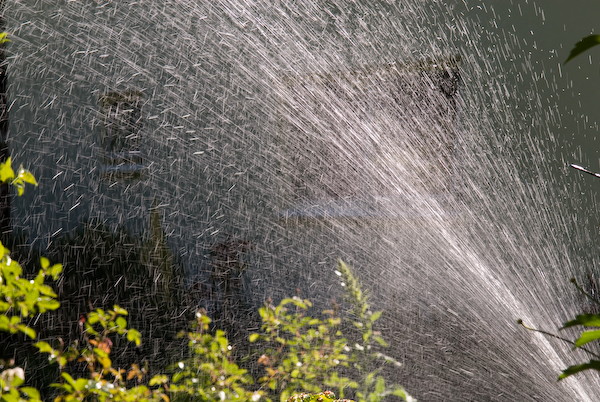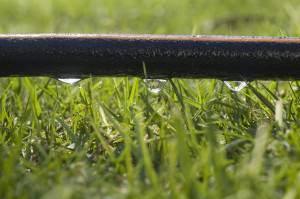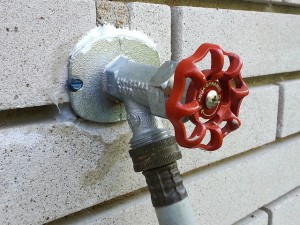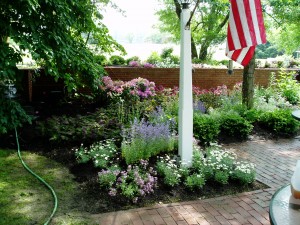"We Do Things"

Complete Landscape & Lawn Maintenance
Phone: (804) 639-1554
Email: wrightwaylawn@aol.com
Watering Instructions

- Don't rely on Mother Nature: Rainfall can be very deceiving. You think the great 45 minute thunderstorm just watered your plants beautifully, but half of it ran off into the lawn because it rained so hard, and only the top couple of inches of the mulch is wet. Unless it rains a light, soaking rain for at least 4 to 5 hours, don't even consider natural precipitation as "watering."
- Standing with a hose is not good enough most times: It may work for tiny flowers with 2" to 3" of a root system, but if you think standing there with a hose for a few minutes on that new tree or shrub will matter, you're not doing enough.
- Don't wet the leaf tissue: Those cute little leaves may look thirsty, but they won't absorb water by spraying them. In fact, you can promote fungal diseases by wetting the leaf tissue. Water at the base of plants so the roots can take in water. Try to avoid overhead sprinklers as they will do this as well.
- You can water anytime you want: Obviously early morning and evening are better because less water evaporates from the scorching Sun of Summer, but if you can't water then, do it another time. It's better to do it periodically than not do it all. Just make sure you're watering at the base of the plant. You can even water overnight.
- You're probably not going to water too much: We've only seen this on a couple instances over the past decade here. The overwhelming majority of property owners underestimate how much water their plants should receive on a weekly basis.

How much watering and for how long
This is tough because the answer changes based on how hot it is, how windy it is, how much clay is in your soil, and what type of plant you're watering. There are always variables. Understand that these guidelines are average guidelines. If you have any of those challenges just listed, you'll have to adjust the numbers for your situation. For instance, if it is 90 to 100 degrees for a week, you'll have to ramp up your efforts.
Your plants are immature for at least a year. The larger the plant installed, the longer it will take to repair it's root system with tiny, fibrous roots that will reach out into the soil for moisture. Be prepared to water when needed for the first year. If the weather gets to freezing, you won't need to continue watering until it warms up later in the year. You will need to water 3 to 4 times a week depending upon the heat, lack of rainy days, and soil conditions. If conditions are more severe or favorable, you'll need to adjust.

How to Water a Tree
Key Principles: How big is the root ball? You aren't just watering the first couple inches of soil. Your goal is to slowly water the soil/mulch over the root ball so that the water does not run off, and slowly percolates down into the soil, soaking the entire root zone. An average tree that we install has a root ball of 20" - 30" deep. Understand now why standing there with a hose for a few minutes doesn't work?
How to get the job done: The easiest and cheapest way to water a tree is to lay a hose at the base of the trunk, a few inches away. Turn the hose on a slow trickle and watch it. If you're getting a bunch of run off, you need to turn the hose down. You will most likely need to have the hose run for an hour on 3 positions around the trunk. If that doesn't seem like the method for you, you can use soaker hoses. These foam hoses connect to the end of a standard garden hose and drip water out their sides. Radiate the hose around the base of your trees so that they are spiraling over the whole root ball. Be careful not to connect too many soaker hoses together or the ones on the end won't be getting enough water pressure. Usually after 100' of hose you'll start losing pressure. You won't want the hose turned on more than 1/4 or 1/2 of the way. If you're looking for another method, another one that works great is using irrigation bags or containers around the base of the plants. These reservoirs fill up quickly with 10+ gallons of water and have small holes on the bottom that will slowly drip to water the trees.

How to Water Shrubs
Key Principles: The same principles that apply for a tree apply to shrubs, but with a lesser scale. Shrubs come in a variety of sizes of containers and root balls. Understand your goal is to get that whole root ball moist. How big is the root ball? You aren't just watering the first couple of inches of soil. Your goal is to slowly water the soil/mulch over the root ball so that the water does not run off, and slowly percolates down into the soil, soaking the entire root zone. An average shrub that we install has a root ball of 12" to 20" deep.
How to get the job done: The easiest and cheapest way to water shrubs is to lay a hose at the base of the plant, a few inches away. Turn the hose on a slow trickle and watch it. If you're getting a bunch of run off, you need to turn the hose down. You will most likely need to have the hose run for about 10 to 20 minutes at 2 - 3 positions around the trunk. If that doesn't seem like the method for you, you can use soaker hoses. Radiate the hose around the base of your shrubs so that they are spiraling around the root ball. Be careful not to connect too many soaker hoses together or the ones on the end won't be getting enough water pressure. Usually after 100' of hose you'll start losing pressure. You won't want the hose turned on more than 1/4 or 1/2 of the way.

How to water Perennials, Annuals & Groundcovers
Key Principles: Most of these plants will only have roots in the first 3" to 8" of soil after they're planted. This means a different approach. You won't have to water quite as long in each location, but you may have that top few inches of soil and mulch dry out quickly depending on conditions. Whereas when you water a tree, the moisture is still down in the majority of the root system even if the top few inches dry out; and with small plants, you may need to water more frequently if it's hot and dry.
How to get the job done: You can use a watering wand (similar to a shower head) on the end of your hose and water each plant individually for 15 to 20 seconds, then give it about a 20 second break (you can move on to the next plant) and then come back and repeat that 15 to 20 second watering again for that small plant. If you have large areas of annuals or groundcover you may want to consider using an overhead sprinkler. Just be sure you aren't watering within 3 to 4 hours from dusk, so the plant leaves don't remain wet all night and promote fungal diseases. If you're using an overhead sprinkler, you'll need to run your sprinklers a couple of times a day for about 20 minutes each time.
How to tell if you're doing it correctly: Don't wait for the plants to tell you with wilting and leaves dropping off. Then you'll just be watering to keep the plant's roots alive so it may be possible to come back later. Inspect the soil. Dig around with your hands, soil probe, garden trowel, or shovel. You'll be able to tell quickly how far down you're actually watering.
We wish you the best of luck! If you take the time and commit to watering correctly, you'll get the most out of your investment and have beautiful, healthy plants.



Wright Way Lawn Service, Inc.
Phone: (804) 639-1554
Email: wrightwaylawn@aol.com
Home / Lawn Maintenance / Landscaping / Turf / Snow Removal /About / Contact / Watering Instructions /Employment / Gallery / Reviews
Site Powered by Moneynet Marketing